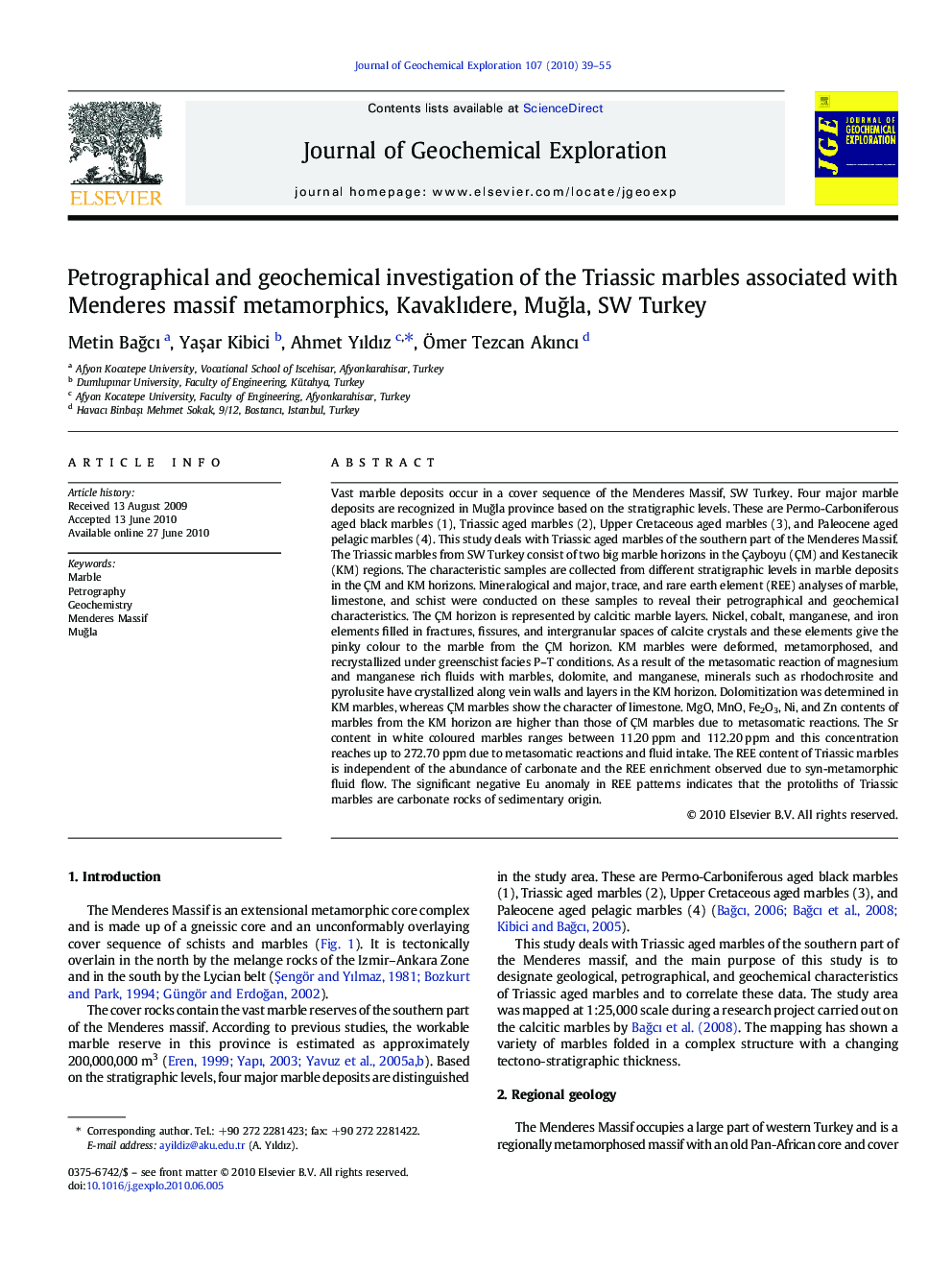| کد مقاله | کد نشریه | سال انتشار | مقاله انگلیسی | نسخه تمام متن |
|---|---|---|---|---|
| 4457937 | 1312643 | 2010 | 17 صفحه PDF | دانلود رایگان |

Vast marble deposits occur in a cover sequence of the Menderes Massif, SW Turkey. Four major marble deposits are recognized in Muğla province based on the stratigraphic levels. These are Permo-Carboniferous aged black marbles (1), Triassic aged marbles (2), Upper Cretaceous aged marbles (3), and Paleocene aged pelagic marbles (4). This study deals with Triassic aged marbles of the southern part of the Menderes Massif. The Triassic marbles from SW Turkey consist of two big marble horizons in the Çayboyu (ÇM) and Kestanecik (KM) regions. The characteristic samples are collected from different stratigraphic levels in marble deposits in the ÇM and KM horizons. Mineralogical and major, trace, and rare earth element (REE) analyses of marble, limestone, and schist were conducted on these samples to reveal their petrographical and geochemical characteristics. The ÇM horizon is represented by calcitic marble layers. Nickel, cobalt, manganese, and iron elements filled in fractures, fissures, and intergranular spaces of calcite crystals and these elements give the pinky colour to the marble from the ÇM horizon. KM marbles were deformed, metamorphosed, and recrystallized under greenschist facies P–T conditions. As a result of the metasomatic reaction of magnesium and manganese rich fluids with marbles, dolomite, and manganese, minerals such as rhodochrosite and pyrolusite have crystallized along vein walls and layers in the KM horizon. Dolomitization was determined in KM marbles, whereas ÇM marbles show the character of limestone. MgO, MnO, Fe2O3, Ni, and Zn contents of marbles from the KM horizon are higher than those of ÇM marbles due to metasomatic reactions. The Sr content in white coloured marbles ranges between 11.20 ppm and 112.20 ppm and this concentration reaches up to 272.70 ppm due to metasomatic reactions and fluid intake. The REE content of Triassic marbles is independent of the abundance of carbonate and the REE enrichment observed due to syn-metamorphic fluid flow. The significant negative Eu anomaly in REE patterns indicates that the protoliths of Triassic marbles are carbonate rocks of sedimentary origin.
Research Highlights
► Bullet Point 1: The cover rocks contain the vast marble reserves of the southern part of the Menderes massif. Based on the stratigraphic levels, four major marble deposits are distinguished in the study area. These are Permo-Carboniferous aged black marbles (1), Triassic aged marbles (2), Upper Cretaceous aged marbles (3), and Paleocene aged pelagic marbles (4).
► Bullet Point 2: The Triassic marbles are known as Milas and Muğla marbles in the literature. The marbles are interbedded with millimetre to centimetre scale layers of calcite quartz, muscovite, biotite, serpentine, garnet, and amphibole schist, producing a rhythmic banding. The Triassic marbles are divided into two big marble horizons. They are named Çayboyu marble (ÇM) horizon and Kestanecik marble (KM) horizon due to their different colours and fabrics. ÇM horizon is older than KM horizon according to their stratigraphic findings.
► Bullet Point 3: The Çayboyu marble (ÇM) horizon is represented by seven layers. The ÇM horizons having different colours and patterns are commercially known as Muğla royal, Muğla blue wave, Muğla rapsody, Muğla rosa bellisimo, Muğla bellisimo, and Muğla silver in the marble industry.
► Bullet Point 4: In the KM horizon, the Milas Marbles having various colours and patterns are known by different names such as Milas white, veined, pearl, aubergine, lilac, and lemon in the marble trade. Milas veined and Milas lilac marbles are strongly fractured and folded and have a brecciated appearance. As a result of the metasomatic reaction of these fluids with marbles from the KM horizon, dolomite and manganese minerals such as rhodochrosite and pyrolusite crystallized along vein walls.
► Bullet Point 5: The intake of metasomatic reactions and the intake of minerals including fluids in the study area changed properties such as appearance and mineralogical composition, led to local alteration of marbles, and ensured enrichment of major, trace, and REE contents in some marble layers, and these changes enhance the HYPERLINK "http://www.tureng.com/search/desirability" desirability of marbles from the ÇM and KM horizons.
Journal: Journal of Geochemical Exploration - Volume 107, Issue 1, October 2010, Pages 39–55